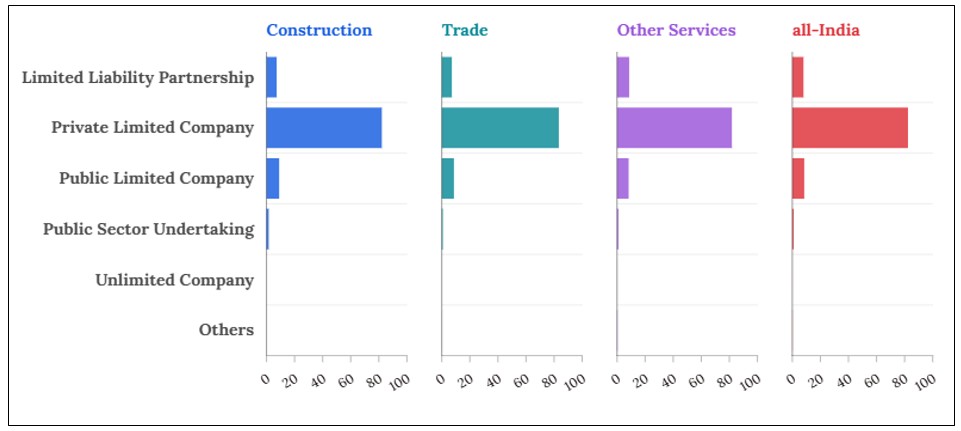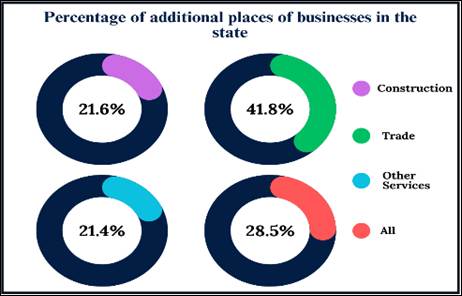Ministry of Statistics & Programme Implementation
Pilot Study on Annual Survey of Services Sector Enterprises (ASSSE) to capture insights into the Incorporated Service Sector
Posted On:
30 APR 2025 4:00PM by PIB Delhi
The pilot study was carried out in two phases using a GSTN frame primarily with an objective to test the suitability of the GSTN database as sampling frame, verify and update selected frame information (in Phase-I) and to test the operational modalities such as, response of the enterprises, adequacy of the instruction, structure of the questionnaire, collectability of information, etc. (in Phase-II).
The pilot study covered those service sector enterprises from the GSTN database which are registered under Companies Act, 1956 or, Companies Act, 2013 or Limited Liability Partnership (LLP) Act, 2008.
The pilot provides valuable operational insights and a foundation for launching a robust, full-scale annual survey of incorporated service sector enterprises from January 2026.
Objective of the Pilot Survey on ASSSE
- The service sector is a key driver of India's economy, contributing more than 50% to the country's GDP and providing millions of jobs. Accurate and comprehensive data on this sector is crucial for informed policymaking, strategic planning, and investment decisions. While the unincorporated part of the service sector is covered in Annual Survey of Unincorporated Sector Enterprises (ASUSE) conducted by National Statistics Office, there is a lack of granular data on the economic and operational characteristics, employment, and other related aspects of the incorporated service sector. This gap in data is primarily due to the absence of a regular national-level survey covering the various sub-sectors of the incorporated non-agricultural non-manufacturing sectors.
- The main objective was to test operational processes - enterprise response, clarity of survey instructions, efficacy of the questionnaire and the availability of key data from official records such as books of accounts, profit and loss statements, and labour registers.
Requirement of Pilot Study before launching full-fledged ASSSE
To firm up the methodology, survey instruments and other operational aspects of conducting a full-fledged pan-India survey (ASSSE), there was a felt need to undertake a pilot. Accordingly, the Ministry of Statistics and Programme Implementation (MoSPI) has conducted the Pilot Study on ASSSE and releases its findings as a Technical Report in this press note.
This pilot marks a pioneering effort in the Indian official survey ecosystem, utilizing a GSTN-based enterprise frame for the first time comprising of incorporated enterprises across the Construction, Trade, and Other Services categories including transport, accommodation and food services, information and communication, health, education, real estate, etc. Technical Report available in the website of the MoSPI viz. https://www.mospi.gov.in.
Modalities of conducting the Pilot Study
The Pilot Study on ASSSE has been conducted using an ‘enterprise approach’ where the term ‘enterprise’ is referred to as a GSTN unit conducting operations in a particular state. As per GSTN nomenclature, the term enterprise is analogous to ‘principal place of business’ which may have one or more ‘additional place of business’ (establishments) in the state. Combined data of all the additional places of businesses have been collected from the principal place of business in this pilot study.
The two-phase pilot study, conducted through CAPI (Computer-Assisted Personal Interviewing) on tablets, aimed to test the suitability of GSTN database as sampling frame, validate and update selected frame information, test operational processes, and assess data availability from business records including balance sheets, books of accounts and labour registers maintained by the enterprises for the financial year 2022–2023.
Phase I of the pilot was conducted during May 2024–August 2024 covering 10,005 enterprises primarily to verify and update address and activity information along with collecting some quantitative information such as gross sale value, employment, etc.
Phase-II of the Pilot Study on 5020 enterprises selected from the list of eligible enterprises of Phase-I took place during November 2024 to January 2025. Data for this phase were collected under the Collection of Statistics Act, 2008 (as amended in 2017), with notices issued in October 2024.
Major takeaway from the pilot study
- Majority of the enterprises were found to be existent and operational.
- Units with headquarters in other states required significant effort to collect the relevant data. Also, challenges were faced in bifurcating the GSTIN level information pertaining to the selected enterprises from Pan-India centralized records (often CIN based) maintained at headquarter level.
- Majority of the responding units were found to be cooperative in furnishing information/data.
- Barring a few blocks, the questionnaire was found to be reasonably easy to fill in.
- The instructions were found to be mostly clear and unambiguous and easy to understand.
Key finding of the pilot study (based on unweighted i.e without applying any multiplier on sample observations):
- Distribution of Enterprises by type of organization
In Figure 1, distribution of enterprises by type of organization is presented. It can be seen that majority of the corporate entities in the pilot study on ASSSE are Private Limited Companies (82.40% at overall level) during FY 2022-23 followed by Public Limited Company and Limited Liability Partnership (each having nearly 8% share). The same trend is noticeable for all the Broad Activity Categories (BAC) i.e., Construction, Trade and Other Services.
Figure 1: Distribution of enterprises by type of organization for each BAC

- Percentage share of economic indicators by different size classes of output (FY 2022-23)
|
Size Class of Output (Rs.)
|
No. of enterprises surveyed
|
Indicator*
|
|
Fixed Assets
|
Net Fixed Capital Formation
|
Gross Fixed Capital Formation
|
Gross Value Added
|
Net Value Added
|
Total persons engaged
|
Total compensation
|
|
all-India
|
|
Less than 10 cr.
|
2720
|
2.64
|
2.19
|
2.44
|
1.19
|
1.07
|
9.28
|
3.17
|
|
10 cr. or more, but less than 100 cr.
|
927
|
9.58
|
6.00
|
8.32
|
9.45
|
9.38
|
20.03
|
11.43
|
|
100 cr. or more, but less than 500 cr.
|
326
|
25.00
|
29.08
|
26.96
|
19.90
|
19.33
|
33.73
|
22.24
|
|
500 cr. or more
|
113
|
62.77
|
62.73
|
62.28
|
69.47
|
70.21
|
36.96
|
63.17
|
|
All
|
4086
|
100.00
|
100.00
|
100.00
|
100.00
|
100.00
|
100.00
|
100.00
|
The following Table presents the percentage share of different important indicators over different size-classes of output.
* generated based on sample data without using weights
The data reveals that larger enterprises with output Rupees 500 crores and above dominate in terms of asset ownership (62.77%), net fixed capital formation (62.73%), gross value added (69.47%) and total compensation (63.17%). Further, data also reveals that enterprises (having output below Rupees 500 crores) make up almost account for 63.03% of total employment and 36.84% of total compensation.
Fig. 2: Enterprises with additional places of businesses in the state for each Broad Activity Categories.

The above Figure (Figure 2) shows that overall, 28.5% of enterprises reported having additional places of business within the state. This percentage was observed to be the highest in the Trade sector with around 41.8% of enterprises belonging to this sector reported additional places of business in the state. As per GSTN nomenclature, the term enterprise is analogous to ‘principal place of business’ which may have one or more ‘additional place of business’ (establishments) in the state.
Way Forward
- The pilot study on ASSSE represents a significant milestone in strengthening India’s statistical infrastructure for the service sector, a key contributor to both GDP and employment.
- The findings from the pilot study provide a strong foundation for launching the full-scale annual survey starting in January 2026.
- The pilot study confirmed the suitability of the GSTN database as a sampling frame for the survey.
- It highlighted the importance of proper verification and validation of survey instruments, the collectability of data from records maintained by selected enterprises and the challenges encountered during data collection.
- The pilot study offers valuable insights for planning and finalizing the sampling design, determining the sample size and refining the questionnaire for the full-fledged survey in consultation with major stakeholders.
- The major indicators of the survey include percentage share of Fixed Assets, Net fixed Capital Formation, Gross Fixed Capital Formation, GVA, NVA, number of persons engaged and compensation etc. over different size-classes of output.
Important Caveat
The basic purpose of the pilot study was experience gathering on various aspects of the survey (as mentioned in previous paras) rather than generating estimates. Considering the small sample size of only 5020 units and the fact that a number of selected units were found to be non-existing and/or non-responding for various reasons, no design-based estimate (using sampling weights) has been attempted in this pilot study. Hence the estimates of any sector or Broad Activity Category (BAC) obtained by summing the estimates of all enterprises belonging to that sector/BAC tend to be skewed towards the estimates of large units present in that sector/BAC. Thus, the estimates are not indicative of or comparable to the overall actual aggregates of the sector/BAC.
****
Samrat/ Allen
(Release ID: 2125454)
Visitor Counter : 1320